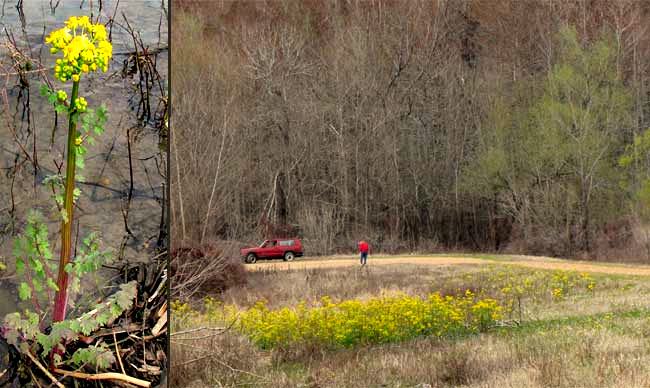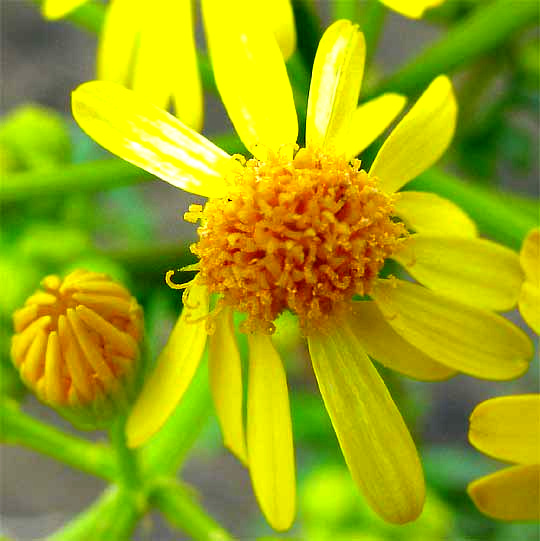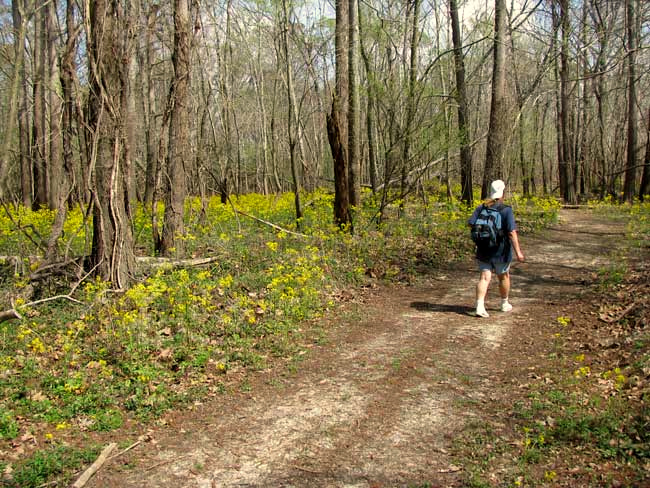Excerpts from Jim Conrad's
Naturalist Newsletter

from the the March 2, 2009 Newsletter, issued from the forest near Natchez, Mississippi; elevation ~400ft (120m), ~N31.47°, ~W91.29°:
"BUTTERWEED'S BRIGHT SPLASHES
Above you see Karen looking for fossils on the gravel road through Catherine Creek NWR. Between her and myself lies a splash of yellowness providing a springy feeling to the otherwise gray and brown landscape (though note some of the trees beyond slightly tinged green and red with spring growth).
The inset at the picture's far left shows the plant producing the yellowness. That's "Butterweed," PACKERA GLABELLA. I put "Butterweed" inside quotation marks because several plants go by that name. Another name sometimes used for it is Groundsel. This is a good plant to know because it's often abundant, producing one of the earliest unmistakable signs of spring, especially for those who see "nature" only from their car.

Above you see a close-up of an opening flower head (on the left) and a completely open one. The open one shows us that this "Butterweed" is a member of the Composite or Sunflower Family, for you're actually seeing many flowers packed together in a single "composite" head.
I've always placed this species in the genus Senecio, so finding out that recent studies have shifted it and a few other Senecio species into the genus Packera was a surprise. The species is native to the US Southeast and a little beyond.<

from the the March 16, 2009 Newsletter, issued from the forest near Natchez, Mississippi; elevation ~400ft (120m), ~N31.47°, ~W91.29°:
A STRANGE & BEAUTIFUL ENVIRONMENT
In the Refuge, Karen and I hiked several miles down a seldom-used ATV trail through the bottomland forest adjacent to the Homochitto River. You can see Karen on the trail through that unusual environment above. Mile after mile the forest floor we passed over was brilliant with flowerings of the yellow-blossomed wildflower seen in that picture. The plant is Butterweed, PACKERA GLABELLA.
Seldom does one wildflower species so completely dominating an ecological niche over such a large area. Surely it's because Butterweed's adaptations enable it to survive in a very unstable environment -- unstable because often these bottomlands are flooded beneath several feet of water, and the flooding comes at different times of the year. Some years they'd be flooded now. When snow and ice up north start melting and spring rains kick in, they may flood again in a few weeks.
Whatever their germination biology, for us Butterweed created an ephemeral, enchanted community we felt honored to walk through. This was not only because of the flowers' brilliant color but also because of their sweet perfume. You don't think of Butterweed flowers as being particularly sweet smelling, but when there are millions and millions of them, the odor is intoxicating.